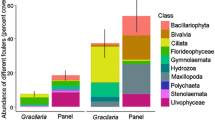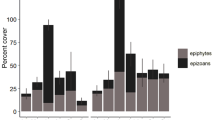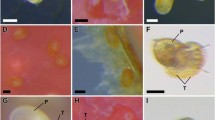Abstract
We examined the chemical antifouling properties of four sublittoral red algae, Chondrus crispus, Delesseria sanguinea, Osmundea ramosissima, and Polyides rotundus, which are all rarely fouled in the field. Two different approaches were used. Firstly, we tested the effects of lipophilic crude extracts on the settlement behaviour of cyprid larvae of the co-existing barnacle Balanus improvisus. Secondly, in a settlement preference experiment, we tested whether B. improvisus cyprid larvae settle on living algae when given a choice between natural algal surfaces and control surfaces. With this procedure, we were able to test both if the algae inhibit recruitment of cyprids, and if this inhibition is a result of chemistry. The settlement of B. improvisus larvae was strongly inhibited at concentrations estimated to be potentially ecologically relevant for all of the tested extracts. However, only C. crispus significantly inhibited settlement in the preference experiment, even though there was also a tendency for settlement inhibition on P. rotundus and O. ramosissima. In contrast, D. sanguinea seemed to stimulate settlement. This contradiction probably resulted from an extraction of metabolites that naturally occur only inside the alga. However, as this study shows, a combination of settlement assays with whole-cell extracts and preference tests of ecologically relevant fouling organisms on natural algal and control surfaces may be a useful procedure to avoid erroneous conclusions regarding natural antifouling roles of compounds based on settlement assays with only whole-cell extracts. Furthermore, this study also shows that production of inhibitory metabolites may explain the low degree of fouling, especially by B. improvisus, on C. crispus.



Similar content being viewed by others
References
Athanasiadis A (1996) A bibliography and biogeography of Scandinavian Rhodophyta and Phaeophyta. Algologia, Göteborg
Berntsson KM (2001) Larval behaviour of the barnacle Balanus improvisus with implications for recruitment and biofouling control. PhD thesis, Department of Marine Ecology, Göteborg University
Berntsson KM, Jonsson PR, Lejhall M, Gatenholm P (2000) Analysis of behavioural rejection of micro-textured surfaces and implications for recruitment by the barnacle Balanus improvisus. J Exp Mar Biol Ecol 251:59–83
Bouarab K, Potin P, Correa J, Kloareg B (1999) Sulfated oligosaccharides mediate the interaction between a marine red alga and its green algal pathogenic endophyte. Plant Cell 11:1635–1650
Brawley SH (1992) Mesoherbivores. In: John DM, Hawkins SJ, Price JH (eds) Plant–animal interaction in the marine benthos. (Systematics Association special volume no. 46) Clarendon Press, Oxford, pp 235–263
Chevolot L, Cochard JC, Yvin JC (1991) Chemical induction of larval metamorphosis of Pecten maximus with a note on the nature of naturally occurring triggering substances. Mar Ecol Prog Ser 74:83–89
Clare AS (1996) Natural product antifoulants: status and potential. Biofouling 9:211–229
Collen J, Delrio MJ, Garciareina G, Pedersen M (1995) Photosynthetic production of hydrogen peroxide by Ulva rigida C. Ag. (Chlorophyta). Planta 196:225–230
Da Gama BAP, Pereira RC, Carvalho AGV, Coutinho R, Yoneshigue-Valentin Y (2002) The effects of seaweed secondary metabolites on biofouling. Biofouling 18:13–20
Dahlström M, Martensson LGE, Jonsson PR, Arnebrant T, Elwing H (2000) Surface active adrenoceptor compounds prevent the settlement of cyprid larvae of Balanus improvisus. Biofouling 16:191–203
D'Antonio CD (1985) Epiphytes on the rocky intertidal red alga Rhodomela larix (Turner) C. Agardh: negative effects on the host and food for herbivores? J Exp Mar Biol Ecol 86:197–218
Davis A, Targett N, McConnell O, Young C (1989) Epibiosis of marine algae and benthic invertebrates: natural products chemistry and other mechanisms inhibiting settlement and overgrowth. In: Scheuer PJ (ed) Bioorganic marine chemistry, vol 3. Springer, Berlin Heidelbeg New York, pp 85–114
De Nys R, Steinberg PD (1999) Role of secondary metabolites from algae and seagrasses in biofouling control. In: Fingerman M, Nagabhushanam R, Thompson MF (eds) Recent advances in marine biotechnology, vol 3. Science, Enfield, N.H., pp 223–244
De Nys R, Steinberg PD, Willemsen P, Dworjanyn SA, Gabelish CL, King RJ (1995) Broad spectrum effects of secondary metabolites from the red alga Delisea pulchra in antifouling assays. Biofouling 8:259–271
De Nys R, Leya T, Maximilien R, Afsar A, Nair PSR, Steinberg PD (1996a) The need for standardised broad scale bioassay testing: a case study using the red alga Laurencia rigida. Biofouling 10:213–224
De Nys R, Steinberg PD, Rogers CN, Charlton TS, Duncan MW (1996b) Quantitative variation of secondary metabolites in the sea hare Aplysia parvula and its host plant, Delisea pulchra. Mar Ecol Prog Ser 130:135–146
De Nys R, Dworjanyn SA, Steinberg PD (1998) A new method for determining surface concentrations of marine natural products on seaweeds. Mar Ecol Prog Ser 162:79–87
Dixon J, Schroeter SC, Kastendiek J (1981) Effects of the encrusting bryozoan, Membranipora membranacea, on the loss of blades and fronds by the giant kelp, Macrocystis pyrifera (Laminariales). J Phycol 17:341–345
Dixon PS, Irvine LM (1977) Seaweeds of the British Isles, vol 1. Rhodophyta, Part 1. Introduction, Nemaliales, Gigartinales. Natural History Museum, London
Dworjanyn SA, de Nys R, Steinberg PD (1999) Localisation and surface quantification of secondary metabolites in the red alga Delisea pulchra. Mar Biol 133:727–736
Friedlander M, Kashman Y, Weinberger F, Dawes CJ (2001) Gracilaria and its epiphytes 4. The response of two Gracilaria species to Ulva lactuca in a bacteria-limited environment. J Appl Phycol 13:501–507
Gonzalez MA, Goff LJ (1989) The red algal epiphytes Microcladia coulteri and Microcladia californica (Rhodophyceae, Ceramiaceae) II. Basiphyte specificity. J Phycol 25:558–567
Hay ME (1996) Marine chemical ecology: what's known and what's next? J Exp Mar Biol Ecol 200:103–134
Jennings JG, Steinberg PD (1997) Phlorotannins versus other factors affecting epiphyte abundance on the kelp Ecklonia radiata. Oecologia 109:461–473
Johnson CR, Mann KH (1986) The crustose coralline alga, Phymatolithon Foslie, inhibits the overgrowth of seaweeds without relying on herbivores. J Exp Mar Biol Ecol 96:127–146
Keats DW, Knight MA, Pueschel CM (1997) Antifouling effects of epithallial shedding in three crustose coralline algae (Rhodophyta, Coralinales) on a coral reef. J Exp Mar Biol Ecol 213:281–293
König GM, Wright AD (1997) Laurencia rigida: chemical investigations of its antifouling dichloromethane extract. J Nat Prod 60:967–970
König GM, Wright AD, de Nys R (1999) Halogenated monoterpenes from Plocamium costatum and their biological activity. J Nat Prod 62:383–385
Kupper FC, Kloareg B, Guern J, Potin P (2001) Oligoguluronates elicit an oxidative burst in the brown algal kelp Laminaria digitata. Plant Physiol 125:278–291
Lau SCK, Qian PY (1997) Phlorotannins and related compounds as larval settlement inhibitors of the tube-building polychaete Hydroides elegans. Mar Ecol Prog Ser 159:219–227
Maggs CA, Hommersand MH (1993) Seaweeds of the British Isles, vol 1. Rhodophyta, part 3A. Ceramiales. Natural History Museum, London
Pawlik JR (1992) Chemical ecology of the settlement of benthic marine invertebrates. Oceanogr Mar Biol 30:273–335
Schmitt TM, Hay ME, Lindquist N (1995) Constraints on chemically mediated coevolution: multiple functions for seaweed secondary metabolites. Ecology 76:107–123
Seed R (1985) Ecological pattern in the epifaunal communities of coastal macroalgae. In: Moore PG, Seed R (eds) The ecology of rocky coasts. Hodder and Stoughton, London, pp 22–35
Sieburth J, Tootle J (1981) Seasonality of microbial fouling on Ascophyllum nodosum (L.) Lejol., Fucus vesiculosus L., Polysiphonia lanosa (L.) Tandy and Chondrus crispus Stackh. J Phycol 17:57–64
Steinberg P, de Nys R, Kjelleberg S (2001) Chemical mediation of surface colonization. In: McClintock JB, Baker BJ (eds) Marine chemical ecology. CRC Press, Boca Raton, Fla., pp 355–387
Steinberg PD, de Nys R (2002) Chemical mediation of colonization of seaweed surfaces. J Phycol 38:621–629
Tringali C (1997) Bioactive metabolites from marine algae: recent results. Curr Org Chem 1:375–394
Underwood AJ (1997) Experiments in ecology: their logical design and interpretation using analysis of variance. Cambridge University Press, Cambridge
Wahl M, Hay ME (1995) Associational resistance and shared doom: effects of epibiosis on herbivory. Oecologia 102:329–340
Weinberger F, Friedlander M (2000) Response of Gracilaria conferta (Rhodophyta) to oligoagars results in defense against agar-degrading epiphytes. J Phycol 36:1079–1086
Weinberger F, Friedlander M, Hoppe HG (1999) Oligoagars elicit a physiological response in Gracilaria conferta (Rhodophyta). J Phycol 35:747–755
Williams GA, Seed R (1992) Interactions between macrofaunal epiphytes and their host algae. In: John DM, Hawkins SJ, Price JH (eds) Plant–animal interaction in the marine benthos. (Systematics Association special volume, no. 46) Clarendon Press, Oxford, pp 189–211
Acknowledgements
We are grateful to the staff at Tjärnö Marine Biological Laboratory for their helpfulness. This study was supported by the Swedish Research Council through contract 621-2002-289, by the European Union through the European Regional Development Fund (ERDF) Objective 2 West Sweden, by the Royal Society of Arts and Sciences in Göteborg, and by "Stiftelsen Birgit och Birger Wåhlströms minnesfond för den bohuslänska havs- och insjömiljön". The experiments performed in the present study comply with current Swedish laws.
Author information
Authors and Affiliations
Corresponding author
Additional information
Communicated by L. Hagerman, Helsingør
Rights and permissions
About this article
Cite this article
Nylund, G.M., Pavia, H. Inhibitory effects of red algal extracts on larval settlement of the barnacle Balanus improvisus . Marine Biology 143, 875–882 (2003). https://doi.org/10.1007/s00227-003-1093-9
Received:
Accepted:
Published:
Issue Date:
DOI: https://doi.org/10.1007/s00227-003-1093-9




